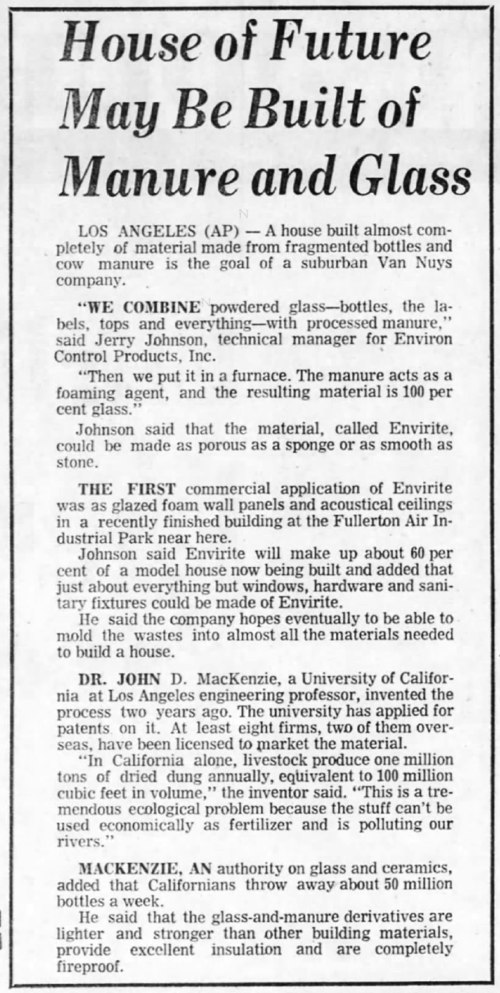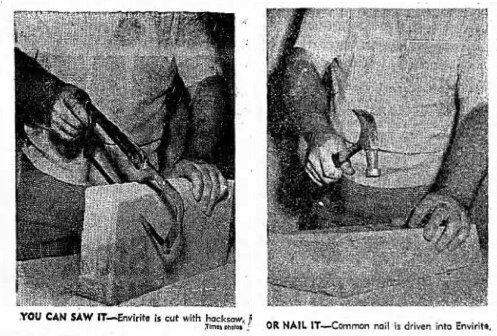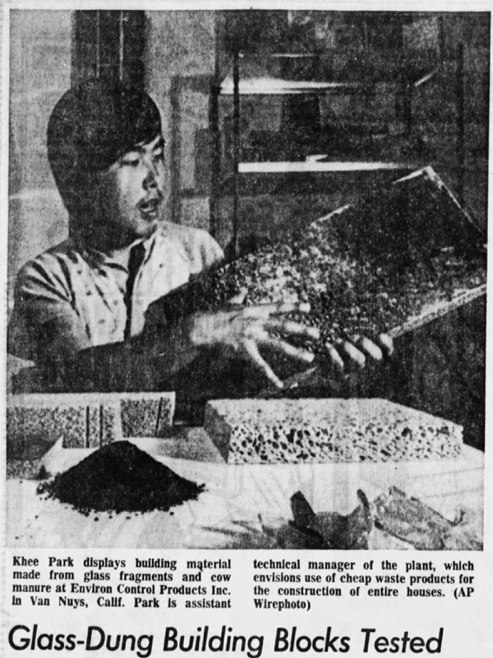Manure Glass
1973 saw the debut of Envirite (aka Glass-Dung, Manure Glass, or Pasture Glass), a promised-to-be revolutionary building material made out of glass and cow manure.
It actually seems like it was a pretty good idea. The concept was that you could take old glass bottles, combine them with cow manure, heat both together in a furnace, and the manure would act as a foaming agent fusing the glass together into a versatile building material. So you'd be repurposing two waste products (old glass and manure) into something useful.
The problem, it seems, was actually getting architects and builders to use the stuff. I found a 1990 article that credited the "inherent conservatism of the building industry" with denying us our glass-manure houses.
Somewhere in here there's a joke about what people who live in glass-manure houses shouldn't do.



It actually seems like it was a pretty good idea. The concept was that you could take old glass bottles, combine them with cow manure, heat both together in a furnace, and the manure would act as a foaming agent fusing the glass together into a versatile building material. So you'd be repurposing two waste products (old glass and manure) into something useful.
The problem, it seems, was actually getting architects and builders to use the stuff. I found a 1990 article that credited the "inherent conservatism of the building industry" with denying us our glass-manure houses.
Somewhere in here there's a joke about what people who live in glass-manure houses shouldn't do.

Lansing State Journal - July 25, 1973

Los Angeles Times - Aug 23, 1973

The Alexandria Town Talk - July 26, 1973
Comments
"The resulting material is 100 percent glass." Maybe he needs to repeat Alchemy 101.
Posted by Virtual on 02/22/17 at 11:29 AM
You can do the same with any carbonaceous material. It supports the glass particles until they're hot enough to fuse together and then burns off.
You can cut it with a hacksaw or drive a nail into it because the pseudo-random structure is very weak and it localizes failures.
I can't see it as a major building material. Individual blocks will range from totally non-porous to being a sieve. There's virtually no way to prevent inclusions (carbon completely surrounded by glass, so it can't burn off), and compression strength will vary from supporting tons to being easily crushed by hand.
You can cut it with a hacksaw or drive a nail into it because the pseudo-random structure is very weak and it localizes failures.
I can't see it as a major building material. Individual blocks will range from totally non-porous to being a sieve. There's virtually no way to prevent inclusions (carbon completely surrounded by glass, so it can't burn off), and compression strength will vary from supporting tons to being easily crushed by hand.
Posted by Phideaux on 02/22/17 at 01:05 PM
On the British show 'Time Team' they were talking about pre-Roman pottery. Amongst other additives to the clay, they added manure. The voids created during firing helped prevent cracking. Yummy!
Posted by BMN on 02/22/17 at 02:20 PM
I agree, Phideaux. It looks to be best used as an opaque material for window openings. I'd bet that it would make a good insulator in walls.
Posted by KDP on 02/22/17 at 02:38 PM
That lack of consistency in production may be what doomed the product rather than the building industry being unwilling to adopt it. That claim doesn't strike me as satisfactory as any company with significant investment expects to float demo projects to prove the viability of the product.
The recycling regime for glass adopted by many US states and entire nations may also have upset the plan if they were relying on getting the glass for the low cost of removing it from grateful communities.
The recycling regime for glass adopted by many US states and entire nations may also have upset the plan if they were relying on getting the glass for the low cost of removing it from grateful communities.
Posted by Eric Pobirs on 02/24/17 at 12:38 AM
@Eric -- the inherent problem in using any reclaimed/recycled material is lack of consistency. Processing necessary to make the material conform to a standard, to ensure good results, usually eliminates the cost/environmental benefits.
It has got me wondering what would happen if you heated hollow glass beads (Mardi Gras) just enough for them to fuse together without collapsing. That might be a very interesting product.
It has got me wondering what would happen if you heated hollow glass beads (Mardi Gras) just enough for them to fuse together without collapsing. That might be a very interesting product.
Posted by Phideaux on 02/24/17 at 01:38 PM
Commenting is not available in this channel entry.



Category: Buildings and Other Structures | 1970s